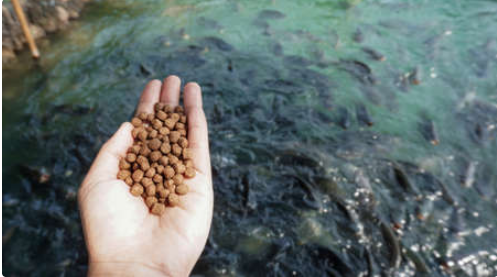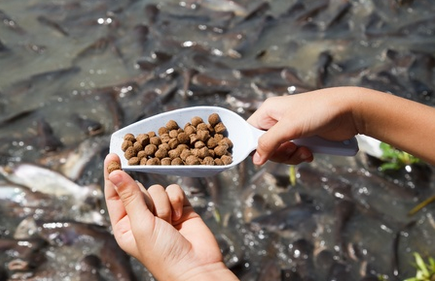Your cart is currently empty!
The Best Feeding Techniques for Your Catfish Farm in 2024
Uncover the power of the best feeding techniques for your catfish farm, serving as a gateway to fostering impressive growth and enduring vitality. Within this article, we’ll delve into the prime strategies for optimizing feeding techniques in your catfish farm.
Similar to how humans flourish with balanced diets, catfish boast unique nutritional prerequisites essential to their all-encompassing health and growth. In the quest for excellence, honing the art of feeding becomes an indispensable tool for catfish farmers.
Proper feeding is far more than merely providing sustenance; it’s a dynamic catalyst propelling growth, sustaining well-being, and playing a pivotal role in the triumph of your catfish farming enterprise.
From cultivating uniform size distribution to fortifying disease resilience, the comprehension and application of effective feeding strategies wield significant influence over the productivity and profitability of your catfish farm.
Within this guide, we embark on a journey into the realm of optimal feeding techniques—an amalgamation of art and science that grants you insights into achieving the most favorable outcomes for your catfish farming venture.
Before delving into the techniques that maximize growth and health on your catfish farm, let’s lay the groundwork by exploring the array of catfish feed types available to nourish your aquatic stock.

Types of Catfish Feed
A variety of catfish feed options exist, each carrying its own set of distinct advantages. These encompass factors such as cost-effectiveness, quality, and accessibility. Before we plunge into the intricacies of optimal feeding techniques, let’s meticulously examine these diverse catfish feeds, unraveling their characteristics and benefits.
Commercial Floating Catfish Feeds: Precision Nutrition
Within the realm of catfish farming, commercial pellets stand as a favored option, and rightfully so. These pellets, meticulously crafted through scientific formulation, deliver an exacting nutritional boost. This ensures that your catfish receives a comprehensive array of essential nutrients with each bite.
Designed to cater to various growth stages, these pellets are offered in diverse sizes, ensuring a seamless fit for your catfish’s development. The convenience and consistency of commercial pellets render them a reliable and steadfast choice embraced by catfish farmers.
However, it’s important to address a common concern linked to commercial catfish feed – the associated high cost. This predicament resonates widely among fish farmers. Take, for instance, the situation in Ghana, where approximately five distinct commercial catfish feeds are available.
While these options provide nutritional excellence, the substantial costs attached can ultimately impact the profitability of your catfish farming venture. Balancing the benefits and costs is a crucial consideration for sustainable success.
Homemade Catfish Feeds: A Personal Touch
For those inclined to impart a personal touch to their catfish’s diet, homemade feeds present a tailor-made alternative. These feeds typically encompass locally sourced ingredients, offering the opportunity to meticulously calibrate nutritional components in alignment with your understanding of your catfish’s specific needs.
It’s worth noting that homemade feeds can offer cost-effectiveness, yet an essential caveat comes into play: ensuring that these feeds adhere to the necessary nutritional benchmarks that facilitate optimal growth and vitality.
As a response to the elevated costs of commercial catfish feeds, an effective strategy emerges – producing your own fish feeds through locally available resources. However, a critical point of consideration rests in maintaining nutritional equilibrium to ensure your catfish receive the required nourishment for their growth.
This guide is your ally in crafting your own homemade catfish feed, carefully attuned to meet all essential nutritional demands. The result? Reduced costs and enhanced profit margins for astute catfish farmers.
Live Feeds: Nature’s Bounty
An array of natural feed alternatives exists for your catfish, encompassing options like duckweeds, Azolla, maggots, and more. However, each of these alternatives presents distinct advantages and challenges. Incorporating these alternative feed sources into your catfish farm demands a certain level of comprehension to ensure sustained growth.
The utilization of these alternative catfish feed options necessitates a comprehensive understanding of their dynamics. To guide you in harnessing the potential of these alternatives for your fish farm, we’ve curated a dedicated guide. This resource is designed to illuminate your path as you explore the realm of alternative catfish feed options, offering insights and strategies to navigate this aspect of catfish farming.
Just as our dietary requirements evolve as we age, catfish exhibit shifting nutritional needs as they traverse different life stages. From fingerlings to juveniles and mature catfish, each phase demands distinct nutrients for fostering optimal growth. Commercial pellets are adeptly calibrated to align with these evolving needs, ensuring a balanced diet for each growth stage.
This principle remains pertinent when producing your own catfish feed or integrating alternative naturally available feed sources. A conscious awareness of these evolving nutritional demands serves as your guiding compass. By factoring in these requisites, you embark on a journey of nurturing catfish that flourish at every stage of their development.
The Best Feeding Techniques for Your Catfish Farm
The delight of any fish farmer lies in witnessing their aquatic companions feed heartily, witnessing their remarkable growth, and reaping substantial rewards. Yet, for this vision to materialize, a fundamental criterion must be met: each fish must receive an equitable share of daily feed, laying the foundation for sustained development.
When executed diligently and patiently, the methods elucidated below promise a panorama of growth uniformity. This translates into consistent advancement across your entire fish population from months to harvest, ultimately yielding a reliable stream of revenue. This practice secures not only the ongoing expansion of your farm but also paves the way for a flourishing future.
LTS Catfish Feeding Method
LTS, an acronym for Location, Time, and Sound, stands as a pivotal technique in enhancing your catfish feeding practices. This method involves several integral components – selecting a dedicated feeding site within the pond, establishing specific feeding intervals (typically twice daily), and employing distinct sounds to alert your catfish to the availability of nourishment.
While some have recommended the broadcasting method for feeding young fish, we’ve found that this approach can inadequately train your fish, causing some to become indifferent to the presence of feed. Unfortunately, this can lead to fish with uneven weight distribution during the harvest.
A strategy that has proven its mettle is training our catfish to anticipate mealtime. This is achieved by designating a precise location for feeding and adhering to a consistent feeding schedule. The outcome? When the designated feeding time arrives, you’ll witness your catfish congregating at the appointed location, eager to feast. This seemingly simple approach carries significant weight, particularly in larger ponds. It ensures timely and uniform feeding, a catalyst for the catfish’s synchronized growth.

To amplify this method, introducing auditory cues can yield remarkable results. The mere act of clapping near the pond during feeding hours triggers an enthusiastic rush as all fish hasten to dine. This auditory cue becomes a powerful ally in nurturing uniform growth and ensuring each fish receives its rightful share of essential nutrients.
Incorporating LTS into your feeding regimen transforms into a cornerstone for optimal growth and health. It not only streamlines feeding practices but also orchestrates a harmonious dining experience that resonates throughout your catfish farm.
From our perspective, the LTS method holds a significantly higher potential for delivering optimal outcomes in your catfish farm, for this reason, we sincerely believe it to be one of the best feeding techniques you can ever adopt for your catfish farm.
Feed to Satisfaction
Amidst the array of calculations dictating daily catfish feed portions up to the sixth month, our methodology at Famerlio diverges. While these calculations might offer value to fellow farmers, our distinction lies in steering clear of this approach. Instead, our pride emanates from nurturing catfish to the impressive benchmark of 1 kg or more by the fourth to fifth month – an accomplishment that deviates from the customary six to seven months undertaken by many.
This distinctive strategy empowers us to yield a higher volume of substantial catfish within each pond, annually.
The foundation of our achievement rests on a dual-pronged approach. Firstly, we harness the potency of the LTS catfish feeding method, as previously elucidated. Beyond this, a critical principle governs our practice: we feed until the fish cease eating.
The initial zeal with which catfish approach their meals gradually wanes as their satiety sets in. Our goal remains steadfast – a patient and consistent stream of feed into the pond until all catfish have indulged. This dedication ensures that each fish receives its due nourishment.
Moreover, we deploy a vital strategy: integrating alternative feed sources, notably duckweed, within the pond’s ecosystem. This thoughtful inclusion guarantees that catfish have access to supplementary sustenance, curbing instances of cannibalism. This strategic move not only reduces production costs but also fosters optimal growth and minimizes any detrimental effects on the pond’s ecosystem.
Our methodology encompasses a holistic approach that redefines catfish feeding, steering toward accelerated growth milestones. It’s a testament to our commitment to innovation, sustainability, and realizing the fullest potential of each catfish under our care.
Ensure Oxygenation
If your water isn’t being re-circulated, then here’s a steadfast directive: integrate aerators, no exceptions. Trust me, disregard any conflicting counsel – the inclusion of aerators in your catfish ponds is non-negotiable. The rationale is clear-cut: maintain optimal oxygen levels consistently.
The vitality of oxygen for catfish growth cannot be overstated. Irrespective of the feed quantities administered, inadequate oxygen levels translate to catfish struggling and, unfortunately, perishing.
Keep in mind, the ultimate aspiration is to grant these aquatic inhabitants the paramount conditions for realizing their peak growth potential. Aerators emerge as the unsung heroes here. They’re budget-friendly and consume minimal power – some models draw as little as 65W. The cost-benefit equilibrium they usher in is remarkable.
Consider this: aerators, in their modest consumption of energy, offer results that border on the astounding. It’s a testament to the transformational power of this simple addition.
Do you identify as a fish farmer? We’re eager to hear your insights. What feeding techniques form the backbone of your approach? Kindly share your experiences in the comment section below. Your perspective is invaluable!
Leave a Reply